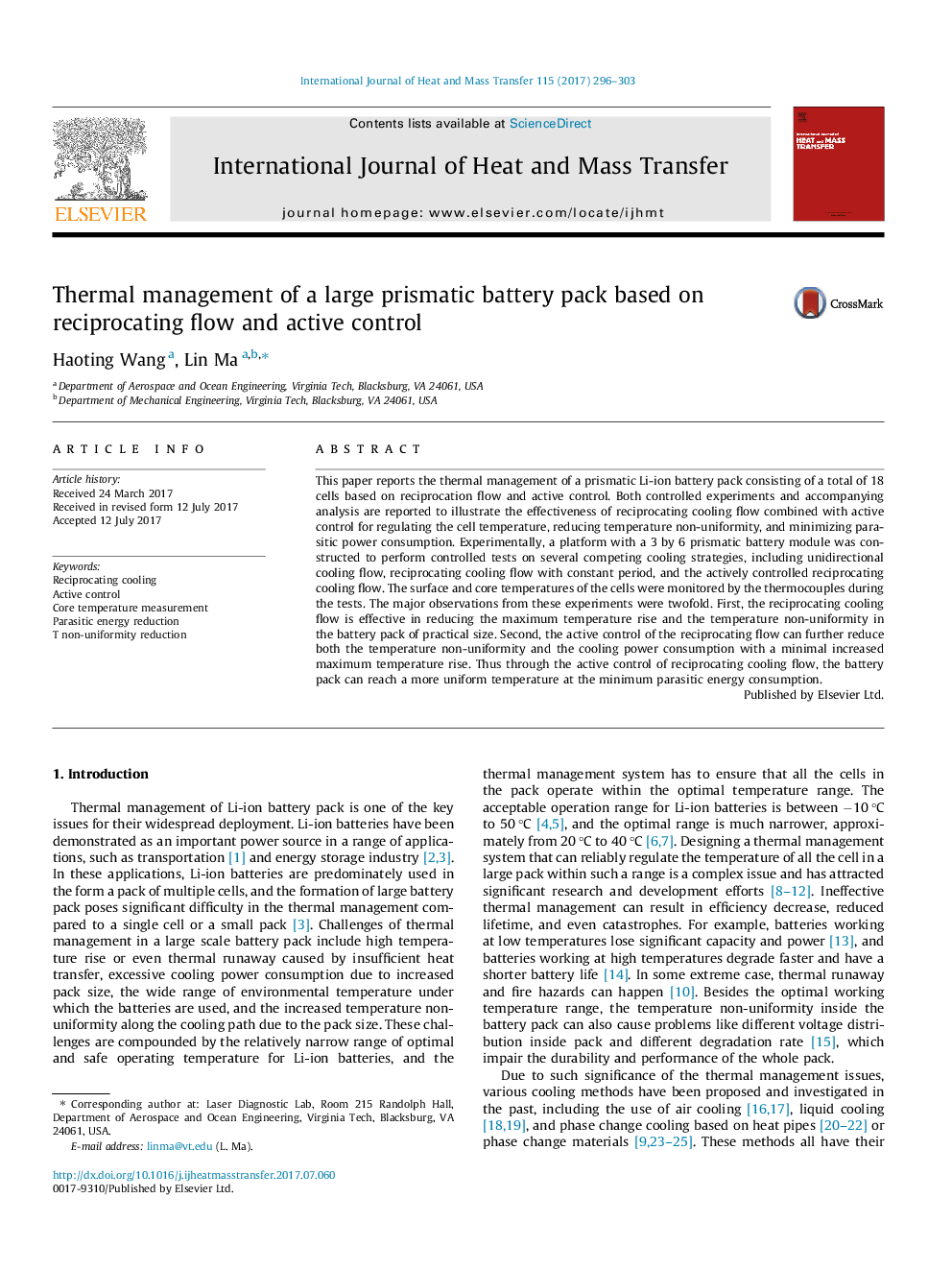| کد مقاله | کد نشریه | سال انتشار | مقاله انگلیسی | نسخه تمام متن |
|---|---|---|---|---|
| 4993467 | 1458026 | 2017 | 8 صفحه PDF | دانلود رایگان |
عنوان انگلیسی مقاله ISI
Thermal management of a large prismatic battery pack based on reciprocating flow and active control
ترجمه فارسی عنوان
مدیریت حرارتی بسته باتری بزرگ با توجه به جریان متقابل و کنترل فعال
دانلود مقاله + سفارش ترجمه
دانلود مقاله ISI انگلیسی
رایگان برای ایرانیان
کلمات کلیدی
ترجمه چکیده
این مقاله مدیریت حرارتی بسته باطری لیتیوم یونهای منعکس شده را شامل می شود که شامل مجموع 18 سلول بر اساس جریان متقابل و کنترل فعال است. هر دو آزمایش کنترل شده و تجزیه و تحلیل همراه گزارش شده است که اثربخشی جریان خنثی مجاور با کنترل فعال برای تنظیم دمای سلول، کاهش یکنواختی دمای و به حداقل رساندن مصرف انرژی پارازیتی نشان داده شده است. در آزمایشگاه، یک پلت فرم با یک ماژول باتری 3 تا 6 پریماسیونی برای انجام آزمایش های کنترل شده بر روی چندین راهبرد رقابت رقابتی، از جمله جریان خنک کننده ی یک طرفه، جریان خنک کننده دو طرفه با دوره ثابت و جریان مستقیم خنک کننده جریان مستقیم فعال، ساخته شد. درجه حرارت سطح و هسته سلول ها در طول آزمایش توسط ترموکوپل ها مورد بررسی قرار گرفت. مشاهدات عمده این آزمایش ها دو برابر بود. اول، جریان خنک کننده مجاور، در کاهش حداکثر افزایش دما و عدم تناسب دما در بسته باتری اندازه واقعی عمل می کند. دوم، کنترل فعال جریان جریان مجدد می تواند هر دو غیر یکنواختی دما و مصرف انرژی خنک کننده را با حداقل افزایش حداکثر افزایش دما کاهش دهد. بنابراین، از طریق کنترل فعال جریان انتقالی مجاور جریان، بسته باتری می تواند به یک دمای یکنواخت تر در حداقل مصرف انرژی انگلیس برسد.
موضوعات مرتبط
مهندسی و علوم پایه
مهندسی شیمی
جریان سیال و فرایندهای انتقال
چکیده انگلیسی
This paper reports the thermal management of a prismatic Li-ion battery pack consisting of a total of 18 cells based on reciprocation flow and active control. Both controlled experiments and accompanying analysis are reported to illustrate the effectiveness of reciprocating cooling flow combined with active control for regulating the cell temperature, reducing temperature non-uniformity, and minimizing parasitic power consumption. Experimentally, a platform with a 3 by 6 prismatic battery module was constructed to perform controlled tests on several competing cooling strategies, including unidirectional cooling flow, reciprocating cooling flow with constant period, and the actively controlled reciprocating cooling flow. The surface and core temperatures of the cells were monitored by the thermocouples during the tests. The major observations from these experiments were twofold. First, the reciprocating cooling flow is effective in reducing the maximum temperature rise and the temperature non-uniformity in the battery pack of practical size. Second, the active control of the reciprocating flow can further reduce both the temperature non-uniformity and the cooling power consumption with a minimal increased maximum temperature rise. Thus through the active control of reciprocating cooling flow, the battery pack can reach a more uniform temperature at the minimum parasitic energy consumption.
ناشر
Database: Elsevier - ScienceDirect (ساینس دایرکت)
Journal: International Journal of Heat and Mass Transfer - Volume 115, Part A, December 2017, Pages 296-303
Journal: International Journal of Heat and Mass Transfer - Volume 115, Part A, December 2017, Pages 296-303
نویسندگان
Haoting Wang, Lin Ma,
